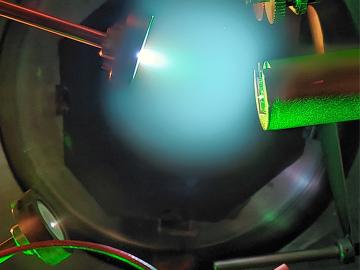
Filter News
Area of Research
- Advanced Manufacturing (6)
- Biology and Environment (19)
- Computational Engineering (1)
- Computer Science (9)
- Energy Frontier Research Centers (1)
- Energy Science (39)
- Fuel Cycle Science and Technology (1)
- Fusion and Fission (14)
- Fusion Energy (7)
- Isotope Development and Production (1)
- Isotopes (2)
- Materials (94)
- Materials Characterization (1)
- Materials for Computing (12)
- Materials Under Extremes (1)
- National Security (14)
- Neutron Science (33)
- Nuclear Science and Technology (18)
- Nuclear Systems Modeling, Simulation and Validation (1)
- Quantum information Science (4)
- Sensors and Controls (1)
- Supercomputing (51)
- Transportation Systems (1)
News Type
News Topics
- (-) Artificial Intelligence (51)
- (-) Biotechnology (14)
- (-) Frontier (17)
- (-) Materials Science (90)
- (-) Microscopy (28)
- (-) Nanotechnology (41)
- (-) Nuclear Energy (47)
- (-) Physics (30)
- (-) Quantum Computing (18)
- (-) Quantum Science (42)
- (-) Security (13)
- 3-D Printing/Advanced Manufacturing (82)
- Advanced Reactors (25)
- Big Data (25)
- Bioenergy (42)
- Biology (47)
- Biomedical (28)
- Buildings (36)
- Chemical Sciences (48)
- Clean Water (16)
- Composites (23)
- Computer Science (105)
- Coronavirus (28)
- Critical Materials (23)
- Cybersecurity (20)
- Education (3)
- Element Discovery (1)
- Emergency (1)
- Energy Storage (75)
- Environment (86)
- Exascale Computing (14)
- Fossil Energy (2)
- Fusion (26)
- Grid (38)
- High-Performance Computing (44)
- Hydropower (6)
- Irradiation (2)
- Isotopes (25)
- ITER (5)
- Machine Learning (27)
- Materials (96)
- Mathematics (3)
- Mercury (5)
- Microelectronics (1)
- Molten Salt (8)
- National Security (21)
- Neutron Science (81)
- Partnerships (33)
- Polymers (23)
- Simulation (19)
- Space Exploration (13)
- Statistics (2)
- Summit (30)
- Transportation (62)
Media Contacts

Using the Frontier supercomputer at ORNL, researchers have developed a new technique that predicts nuclear properties in record detail. The study revealed how the structure of a nucleus relates to the force that holds it together. This understanding could advance efforts in quantum physics and across a variety of sectors, from to energy production to national security.

P&G is using simulations on the ORNL Summit supercomputer to study how surfactants in cleaners cause eye irritation. By modeling the corneal epithelium, P&G aims to develop safer, concentrated cleaning products that meet performance and safety standards while supporting sustainability goals.

Researchers at ORNL joined forces with EPB of Chattanooga and the University of Tennessee at Chattanooga to demonstrate the first transmission of an entangled quantum signal using multiple wavelength channels and automatic polarization stabilization over a commercial network with no downtime.

A team of scientists with two Department of Energy Bioenergy Research Centers — the Center for Bioenergy Innovation at Oak Ridge National Laboratory and the Center for Advanced Bioenergy and Bioproducts Innovation at the University of Illinois Urbana-Champaign — identified a gene in a poplar tree that enhances photosynthesis and can boost tree height by about 30% in the field and by as much as 200% in the greenhouse.

The Department of Energy announced a $67 million investment in several AI projects from institutions in both government and academia as part of its AI for Science initiative. Six ORNL-led (or co-led) projects received funding.

A new technology to continuously place individual atoms exactly where they are needed could lead to new materials for devices that address critical needs for the field of quantum computing and communication that cannot be produced by conventional means.

A study led by the Department of Energy’s Oak Ridge National Laboratory details how artificial intelligence researchers created an AI model to help identify new alloys used as shielding for housing fusion applications components in a nuclear reactor. The findings mark a major step towards improving nuclear fusion facilities.

U2opia Technology has licensed Situ and Heartbeat, a package of technologies from the Department of Energy’s Oak Ridge National Laboratory that offer a new method for advanced cybersecurity monitoring in real time.

In a game-changing study, ORNL scientists developed a deep learning model — a type of artificial intelligence that mimics human brain function — to analyze high-speed videos of plasma plumes during a process called pulsed laser deposition.

A team led by scientists at ORNL identified and demonstrated a method to process a plant-based material called nanocellulose that reduced energy needs by a whopping 21%, using simulations on the lab’s supercomputers and follow-on analysis.


